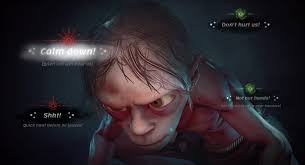In past decades, licensed games were the joke of the industry. Rushed development periods and limited budgets led to poor results and games that were treated more as money makers than something important. That all changed in more recent years, when movie tie-ins became to disappear and be less frequent, and developers like Rocksteady and Insomniac Games delivered incredible games based on popular, iconic and beloved licenses. Thus, the joke is mostly dead and slightly forgotten. At least it was.
Enter The Lord of the Rings: Gollum, a game that wasn’t talked about a lot during development. We never seemed to see a lot of it, as trailers and screenshots were scarce in comparison to other big releases. Unfortunately, that was foreshadowing, because the end result is a flawed, boring and tough to play video game. One that even the most diehard Lord of the Rings fans should probably stay away from.
Developed by Daedalic Entertainment and published by both them and NACON, The Lord of the Rings: Gollum unfortunately and disappointingly harkens back to the days where licensed games were (generally) mediocre-at-best. In fact, it feels like it was ripped out of a bygone era. Perhaps the PlayStation 2’s library, or something. It’s that dated. Granted, we aren’t talking about the good part of the PlayStation 2’s incredible library.

The game begins as Gollum is interrogated after being captured by Aragorn. He then begins to tell his story, including Bilbo Baggins stealing his precious ring of power, and a trip to Mordor a number of years later. It deals with things like imprisonment, slavery, desire and the need for survival, not to mention Gollum’s obsession with said ring.
Later on, our protagonist meets the Candle Man, who wishes to take advantage of the small and stealthy creature.
The mediocre and unfortunately forgettable storyline is told over the course of around ten chapters, each of which can be pretty lengthy. Within these sometimes hour long stages, one must take advantage of the character’s unique abilities, including climbing, jumping long distances, swinging from one handhold to the next and being stealthy. This results in lots of the above, which isn’t as easy as it could have been. Gameplay lag and poor controls hamper the experience, as does not always knowing where to go next. Platforms you can reach blend into the environment, as do other handholds and ledges.

When you’re not being bossed around by grumpy orcs, told to follow someone or engaging in the above, you’ll be trying to stay out of the sight lines of enemies. Some carry rudimentary flashlights, and others carry helmets. Regardless, the goal is to generally completely avoid them unless you cannot.
Sometimes Gollum will have to be slightly creative, by throwing a rock at an environmental item to attract or distract guards. At other times, he’s able to climb onto the backs of, and strangle, certain guards. This is only possible if they don’t have helmets, and that’s not as common as you’d think.
These stealth, avoidance and distraction sequences are often more frustrating than fun due to unpredictable AI, limited freedom and a lot of trial and error. It can be harder to sneak past foes than it should be, and that’s another of the game’s numerous flaws. Furthermore, being detected often leads to an immediate game over and a forced checkpoint restart.

In other stealth games players are given the freedom of choice. That isn’t the case in The Lord of the Rings: Gollum, where one’s routes are generally pre-planned. You’ll generally always be doing what the game wants you to, and what has been preordained. If you’re to sneak past a foe that’s what you’ll do. Conversely, if you’re to take an enemy out stealthily then you’ll have to do that. There’s no real freedom, choice, variety or originality here, and it’s boring. There’s also no combat, meaning that Gollum is both weak and defenceless, though that’s not surprising.
One of the other mechanics at play here involves using dialogue options to make a choice. For example, there are moments where you must decide whether to be good or bad. If you go with the good option then you’re team Sméagol, which is the same side of the character’s personality. However, you can opt to go full Gollum and always pick bad choices. You’ll have to use proof and dialogue options to sway the character, and — for instance — try to sway Gollum to go with your choice, and this involves providing evidence.
I always questioned why Daedalic Entertainment chose to make a game based on Gollum, but hoped the end result would be a nice surprise. However, that didn’t end up being the case. This is a flawed, challenging to play and very dated game, which does not feel like it came out of the year 2023, or anywhere close. It’s more frustrating and boring than fun, and is not worth your time or money.

The Lord of the Rings: Gollum does have the odd good moment, and can feel better than it is when the platforming clicks. It also has some decent voice acting. However, the game looks dated, runs poorly and is very drab. It doesn’t help that it imprisons you in a Mordor slave camp and gives you lots of busywork to do, which is never a fun thing to do in gaming. Doing chores isn’t fun.
You’ve likely already seen screens and memes, but nothing about this game looks all that nice. That includes Gollum’s character model, which is really dated and rough looking. The same is true of other character models — some of which actually look better than that of the main protagonist.
Even if you’re a big fan of The Lord of the Rings, you’ll still want to tread carefully here. The Lord of the Rings: Gollum simply isn’t a good game in any sense of the word. In fact, it’s one of the least fun gaming experiences I’ve had in some time.
This review is based on the Xbox Series S version of the game, which we were provided with.

